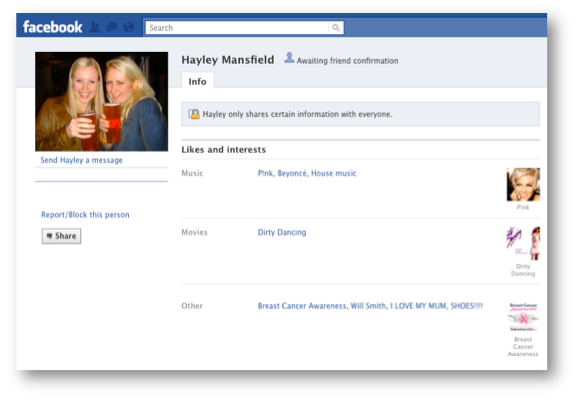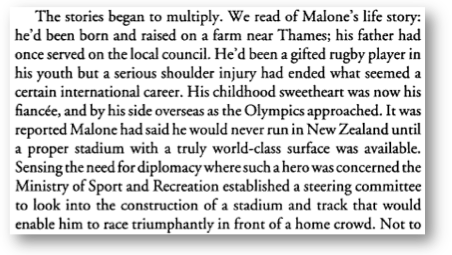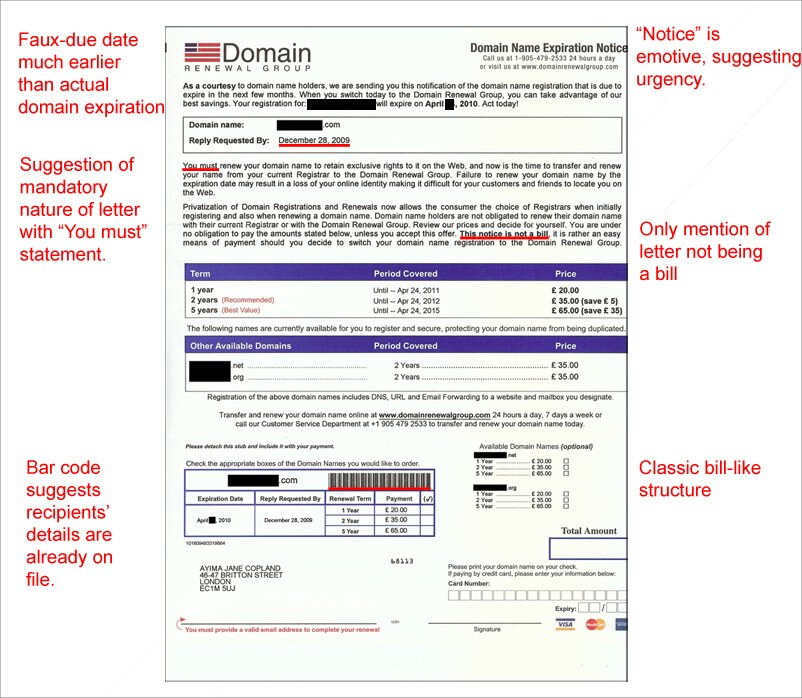What “Motel View” Knows About Marketing: Favatars 2010
2010

Eighteen years ago, Forbes Williams wrote a book called . It’s a collection of stories and my mother gave me a copy when I was fourteen. I don’t know how many times I’ve read it, but some of the stories are as familiar to me as well-known songs. My favourite is about the invention of an imaginary athlete named Stan Malone.
Williams’ protagonist, a sixteen year old named Paul, lives with two flatmates in the hills above Wellington. Bored and creative, the trio embark on a project to invent news stories and have them feature on the national news, and they succeed: once with a fictitious small plane crash, and once with a middle distance runner who was eventually selected to carry the New Zealand flag at the Olympic Games.
Williams’ characters faxed Malone’s imaginary times to New Zealand newspapers, who then published them in the small-print results on sports pages. However, when Malone’s name was left off the team for the upcoming Olympics, there began a national outcry. He was substantially quicker than most of the country’s talent; why was he not to compete?
You couldn’t do exactly this today: the Internet invented real time results reporting (like and this), Ustream web broadcasts through which I’ve watched events from Texas whilst sitting in London, and instantaneous results syndication, ensure more honesty in sports reporting. Malone’s existence would be discredited pretty quickly. However, Williams’ characters did several things right, given their time and place, in their invention of Malone that heightened his chances of succeeding.
The makers of did not.

People unfortunate enough to be embroiled in the may remember that two years ago, social media avatars were the order of the day amongst those who shouted the loudest. “Fake avatars” referred to social media profiles that weren’t portraying real people. Created with the mind to promote something, these soulless shells presumably blended in to your Facebook and Twitter world the way the droids do to your cross-stitch group before they take over your frontal lobe.
This is assuming that the favatars appeared real. The profile above was brought to my attention yesterday by our favourite Frenchman, Ciaran Norris. That’s me in the photo, along with Lisa Myers, at a party in Edgware Road, London, in 2007.
The fake picture along with the “likes” and interests of this girl (which she shares with some of her ) are stereotypically generic. My best guess is that this was created by Al Marketing Guy in his cubicle, and he thought: “What do blond 23 year olds like?” (We so do still look 23. Yes we do, damn it). He came up with Pink, Beyonce, their mums, breast cancer awareness, Will Smith, house music and shoes. SHOES!!!!!
I’m aware that the existence of this girl could still be proven. However, I’ve messaged her twice, written to her Facebook friends, and several people I know have sent her a friend request. Of the two responses I’ve had from her friends, one indicated that he doesn’t know who she is, and the other said, “Probably some spam bot, feel free to report them”. Hayley’s case doesn’t look good.
Al the marketing guy could well have been tasked with the job of social mediaing something–probably something pink–and he needed some chicks to pimp it out.
 Totally better than ur boyfriends iphone AM I RIGHT ladies?
Totally better than ur boyfriends iphone AM I RIGHT ladies?
From the shape of the image, and fact that my Facebook photos are private (I’m guessing Lisa’s are too), it’s likely the marketer got it from the SEOmoz Flickr stream, where it’s public. It certainly shows no signs of being cropped by Facebook, which you’ll often do to a profile picture. Throw on the generic interests, and you’ve got yourself your marketing shell.
But Hayley Mansfield ain’t no Stan Malone. Top level analysis shows that she has no substance, but why was Malone believable and Hayley not? Of course, the irony is that Malone itself is fiction and the invention of Hayley isn’t, but there are some key things in Williams’ story that you really should pay attention to if you want a fake avatar to make its way into the mainstream.
Paul and his flatmates Tristan and Megan didn’t intentionally choose Malone’s circumstances for success, but they were still effective. Firstly, they chose a profession for their character in which the public was inherently interested. The story takes place in 1984 and Malone is a talented athlete. The Los Angeles Olympics are approaching. New Zealand enjoyed a golden era of athletics in the 1960s and 70s (remember?) with the likes of John Walker and Peter Snell dominating world track. 80s Kiwis expected to see good distance runners perform at the Games, and Malone could provide them with that. His inventors timed their invention to coincide with a large event and public interest, even though they didn’t intend to. Remember this. People’s interests move in trends. What will you tie your project to?
Secondly, they didn’t use someone else’s photo. The fake picture of Malone was Paul in a wig. Before the Internet, with Malone “exceptionally shy” and living overseas, a mediocre-quality picture did the trick. Nowadays, you would need a very good disguise of someone who knew he was being used if he were to become a national hero. Alternatively, you’d buy rare stock photos that were unlikely to be found or used by someone else. You couldn’t just take a photo of a real person who would be seen on the street, and you can’t just take the picture of two real people from Flickr who might one day come across it. It was a coincidence that Lisa and I work in marketing, but that sort of chance isn’t once you really want to take.
Thirdly, Tristan. Paul and Megan didn’t try too hard. They set something in motion and then the story created itself. From the book:

The modern day equivalent of this is getting stories written about your subject. It’s getting links. During the years I worked at SEOmoz, I saw things we did and said debated and discussed and passed around until sometimes, the end message was quite different to that with which we’d started. Sometimes this worked in our favour and sometimes it didn’t, but if the goal is to create a phenomenon in which people are interested, chat is gold. The New Zealand public made up their hero in more detail than the three flatmates ever tried to do.
The flatmates did not join whatever 1984′s Facebook groups (women’s magazines? Sports talkback radio?) were with some fake profiles–Malone’s sisters and ex girlfriends and former rivals, perhaps–and tell stories of his past, or talk about how awesome he was and why he should be chosen to carry the flag at the Games. They seeded something so that other people did that. Real people. Hayley Mansfield was undoubtedly created in order to do the former.
Earlier in 2008, prior to Favatargate, Lyndon Antcliffe wrote about that thirteen year old and those hookers. Before Lyndon admitted that the story wasn’t true, the media (namely FOX News) did go a little Malone on it, reporting on the issue and undoubtedly casting opinions on the boy, the parents, the hookers and what it meant for society in general. People would perhaps have even hypothesised about the identity of the family if Lyndon had been more specific about the location (it was only reported to a state level: Texas). He did what great marketing does: set something in motion. Hayley’s generic likes and interests, plus the fact that she won’t have any other photos of herself unless they’re all of Lisa Myers or me, plus the fact that her inventor likely doesn’t have much interest in making her a deeper character, limit her potential.
I am not going to make excuses for lazy Facebook profile making, but I do understand how hard it is to create a realistic fictitious character. I’ve tried it. It’s hard to know what a stranger whose characteristics are different to yours would do or write or think: Sarah Carling wrote a brilliant piece about writing anonymously on SEO Chicks during her interview for the role. It’s hard to be someone you’re not, because you’re very used to being you. It turns out that I’m not good at powering a fake social media profile, but I’m far better at it than the person who chose Lisa’s and my photo.
Awesome marketing stunts usually get found out, and people get upset. I personally don’t mind a fake story (I lived in the US where their TV reporting is largely hyped up garbage, and now I live in the UK where a lot of newspaper reporting is the same, so what’s an actress with a whiteboard when Obama’s apparently a Muslim extremist?). I believe, however, that these aren’t necessarily also awesome marketing, minus the dramatic qualifier.
 Malone gets here; Hayley’s wares do not
Malone gets here; Hayley’s wares do not
Awesome marketing is under the radar. It is the girl on Facebook whose activity isn’t extreme enough or banal enough to look fake. It is the post on Reddit that isn’t crazy or staged enough to be unbelievable, but which is good enough to set a story or meme or idea in motion. It is a story from 1992, set in 1984, that displayed a lot more imagination than someone eighteen years later with the technology of 2010 under their fingers and a photograph of two generic blonde girls in a London pub.
by
by


